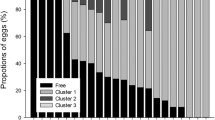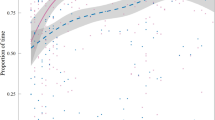Abstract
In crested penguins (Eudyptes spp.), second-laid eggs typically hatch before first eggs. Amongst a variety of factors that have been considered as mechanisms underlying this reversal, has been the idea that crested penguins can adjust the degree of hatching asynchrony by manipulating egg positions (i.e. placing the smaller first egg in the supposedly thermally disadvantaged anterior position) during incubation (termed Preferential Incubation Hypothesis). We tested this in the Snares crested penguin (Eudyptes robustus) and the closely related, but synchronously-hatching, yellow-eyed penguin (Megadyptes antipodes). Snares crested penguins were more likely to place their first eggs, which are smaller than second eggs, in the anterior incubation position than were yellow-eyed penguins, which have a clutch of two similar-sized eggs. But when yellow-eyed penguins, a non-brood reducing species, were provided with an artificial size-dimorphic clutch, they also placed smaller eggs more frequently in the anterior position, suggesting that a general preference exists among penguins to place smaller eggs in the anterior position. Egg temperatures of small first eggs of Snares crested penguins were higher in the anterior than in the posterior position. Large first eggs in lesser size-dimorphic clutches experienced high temperature differences in relation to position, while small first eggs in greater size-dimorphic clutches were incubated at similar temperatures. In yellow-eyed penguins, large eggs within clutches generally had higher egg temperatures than small eggs. Incubation periods of second eggs declined with increasing egg size. Egg-size variation, rather than egg positioning behaviour, influenced hatching patterns in Snares crested penguins. In lesser size-dimorphic clutches, second eggs were more likely to hatch first while in greater size-dimorphic clutches, small first eggs were more likely to hatch at the same time or before the second eggs. This was similar in yellow-eyed penguins, where second eggs hatched earlier in clutches with large first eggs. Our data contradicts the Preferential Incubation Hypothesis and we conclude that this hypothesis is unlikely to explain the reversed hatching asynchrony in crested penguins.






Similar content being viewed by others
References
Ar A (1991) Roles of water in avian eggs. In: Deeming DC, Ferguson MWJ (eds) Egg incubation: its effects on embryonic development in birds and reptiles. Cambridge University Press, Cambridge, pp 229–243
Boersma PD (1982) Why some birds take so long to hatch? Am Nat 120:733–750
Brown CR (1988) Egg temperatures and embryonic metabolism of A- and B-eggs of macaroni and rockhopper penguins. S Afr Tydskr Dierk 23:166–172
Burger AE, Williams AJ (1979) Egg temperatures of the rockhopper penguin and some other penguins. Auk 96:100–105
Clark AB, Wilson DS (1981) Avian breeding adaptations: hatching asynchrony, brood reduction and nest failure. Q Rev Biol 56:253–277
Darby JT, Seddon PJ (1990) Breeding biology of Yellow-eyed Penguins (Megadyptes antipodes). In: Davis LS, Darby JT (eds) Penguin biology. Academic Press, San Diego, pp 45–62
Davis LS, Renner M (2004) Penguins. Poyser, London
Drummond H, Chavelas CG (1989) Food shortage influences siblings aggression in the blue-footed booby. Anim Behav 37:806–819
Edge K-A (1996) Parental investment in penguins. PhD Thesis, University of Otago, Dunedin, New Zealand
Farner DS (1958) Incubation and body temperatures in the yellow-eyed penguin. Auk 75:249–262
Grau CR (1982) Egg formation in Fiordland crested penguins (Eudyptes pachyrhynchus). Condor 84:172–177
Heezik Y van, Davis LS (1990) Effects of food variability on growth rates, fledging sizes and reproductive success in Yellow-eyed Penguins (Megadyptes antipodes). Ibis 132:354–365
Hussell DJT (1972) Factors affecting clutch size in arctic passerines. Ecol Monogr 42:317–364
Kooijman SALM (1993) Dynamic energy budgets in biological systems. Cambridge University Press, Cambridge
Lack D (1947) The significance of clutch size. Ibis 89:302–352
Lamey TC (1990) Hatch asynchrony and brood reduction in penguins. In: Davis LS, Darby JT (eds) Penguin biology. Academic Press, San Diego, pp 399–416
Magrath RD (1990) Hatching asynchrony in altricial birds. Biol Rev 65:587–622
Moreno J, Carrascal LM, Sanz JJ, Amat JA, Cuervo JJ (1994) Hatching asynchrony, sibling hierachies and brood reduction in the chinstrap penguin (Pygoscelis antarctica). Polar Biol 14:21–30
Richdale LE (1957) A population study of penguins. Clarendon Press, Oxford
Ricklefs RE (1993) Sibling competition, hatching asynchrony, incubation period, and lifespan in altricial birds. In: Power DM (ed) Current ornithology, vol 11. Plenum, New York, pp 199–276
Seddon PJ (1989) Patterns of nest relief during incubation period variability in the yellow-eyed penguin (Megadyptes antipodes). NZ J Zool 16:393–400
Slagsvold T, Sandvik J, Rofstad G, Lorentsen O, Husby M (1984) On the adaptive value of intraclutch egg-size variation in birds. Auk 101:685–697
St. Clair CC (1992) Incubation behavior, brood patch formation and obligate brood reduction in Fiordland crested penguins. Behav Ecol Sociobiol 31:409–416
St. Clair CC (1996) Multiple mechanisms of reversed hatching asynchronity in rockhopper penguins. J Anim Ecol 65:485–494
Stoleson SH, Beissinger SR (1995) Hatching asynchrony and the onset of incubation in birds, revisited: when is the critical period? In: Power DM (ed) Current ornithology, vol 12. Plenum, New York, pp 191–270
Stonehouse B (1966) Egg volumes from linear dimensions. Emu 65:227–228
Viñuela J (1997a) Adaptations vs. constraint: intraclutch egg-mass variation in birds. J Anim Ecol 66:781–792
Viñuela J (1997b) Laying order affects incubation duration in the Black Kite (Milvus migrans): counteracting hatching asynchrony? Auk 114:192–199
Warham J (1974a) The breeding biology of behaviour of the Snares crested penguin. J Roy Soc NZ 4:63–108
Warham J (1974b) The Fiordland crested penguin. Ibis 116:1–27
Warham J (1975) The crested penguins. In: Stonehouse B (ed) The biology of penguins. MacMillan, London, pp 189–269
Webb DR (1987) Thermal tolerance of avian embryos: a review. Condor 89:874–898
Williams AJ (1981) The laying interval and incubation period of rockhopper and macaroni penguins. Ostrich 52:226–229
Williams TD (1990) Growth and survival in macaroni penguin, Eudyptes chrysolophus, A- and B-chicks: do females maximise investment in the large B-egg? Oikos 59:349–354
Williams TD, Croxall JP (1991) Chick growth and survival in gentoo penguins (Pygoscelis papua): effect of hatching asynchrony and variation in food supply. Polar Biol 11:197–202
Acknowledgments
We thank Alvin Setiawan, Mike Hazel, Sylviane Neumann, Danilo Hegg, Brad Robson, and Jasmine Lai for help in the field, and John Darby for providing helpful information about yellow-eyed penguins breeding at Boulder Beach. This study was approved by the Department of Conservation and the University of Otago Animal Ethics Committee and complies with the current laws of New Zealand. In particular, we thank Dean Nelson, Bruce McKinlay, Dave Houston, and Jeremy Karol from the Department of Conservation for support and permits. The study was supported by grants from the Yellow-eyed Penguin Trust, a University of Otago Postgraduate Scholarship to M.M. and an Otago Research Grant to L.S.D. Additionally, we thank Colleen Cassady St. Clair and Javier Viñuela, as reviewers, for the helpful comments they made on a previous draft.
Author information
Authors and Affiliations
Corresponding author
Additional information
Communicated by C. Brown
Rights and permissions
About this article
Cite this article
Massaro, M., Davis, L.S. Preferential incubation positions for different sized eggs and their influence on incubation period and hatching asynchrony in Snares crested (Eudyptes robustus) and yellow-eyed penguins (Megadyptes antipodes). Behav Ecol Sociobiol 56, 426–434 (2004). https://doi.org/10.1007/s00265-004-0803-8
Received:
Revised:
Accepted:
Published:
Issue Date:
DOI: https://doi.org/10.1007/s00265-004-0803-8




